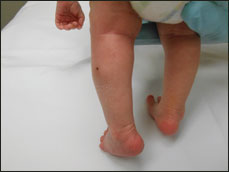Widespread appearance of violaceous lesions in newborn male
Click Here to Manage Email Alerts
After a healthy pregnancy, labor and delivery — complicated only by late prenatal care beginning at 30 weeks when the mother immigrated to Texas from Mexico — a vigorous full-term newborn male is born. However, he was immediately transferred to the neonatal ICU for evaluation and further management of some dramatic, unusual skin lesions.

Additional review of the mother’s record revealed that her prenatal screening included negative HIV, hepatitis B and venereal disease research laboratory (VDRL) test. The mother’s rubella screen revealed her to be non-immune, but she denied any noteworthy illness during her pregnancy.
On examination, the baby had normal vital signs and was appropriate for gestational age in weight, length and head circumference. His general appearance was normal except for numerous, various-sized, fleshy, somewhat violaceous lesions from the crown of his head to his feet, that were well-demarcated with normal-appearing surrounding skin (Figures 1-3). The remainder of his exam was normal, including eyes, liver, spleen and mucous membranes.
The Infectious Diseases Service was consulted to evaluate for congenital infection with extramedullary hematopoiesis. One of the lesions was biopsied, with a hematoxylin and eosin stain of the tissue revealing “dense infiltration of mononuclear cells throughout the dermis with the epidermis looking normal” (Figure 4), which was reported as consistent with “acute monocytic leukemia.”
Figure 1-2. Patient’s general appearance was normal except for numerous, various sized, fleshy, somewhat violaceous lesions from the crown of his head to his feet, that were well demarcated with normal-appearing surrounding skin.
Images:Brien JH
If you had trouble with this one, don’t feel bad; I didn’t know what the patient had with the baby right in front of me. This is a case of congenital aleukemic leukemia cutis (D), a rare condition where leukemic cells infiltrate the dermis without evidence of leukemia by clinical or blood/bone marrow exam. Although I was not sure what the baby had, I knew it was not extramedullary hematopoiesis (EMH) just by the way it looked; the cutaneous manifestation of which typically results in the classic “blueberry muffin” rash as shown in figure 5, a neonate with congenital CMV.
Also, the biopsy of EMH would likely show nucleated red blood cells, erythroblasts, megakaryocytes and myeloid precursors. The biopsy of the patient presented was read as acute monocytic leukemia, and by the time the results were back at 10 days, the lesions had begun to spontaneously regress. At 3 weeks of age, they were barely noticeable (Figures 6 and 7), therefore no bone marrow exam was done and at 1-year follow up, no evidence of leukemia has developed. As noted, this is a very rare condition, occurring at a rate of about 1 per 5 million births.
A bit more common, but still rare is congenital Langerhans cell histiocytosis, which I featured in an August 2010 column. This is a complex and diverse condition characterized by the infiltration of Langerhans cells (activated dendritic cells). The old term was “histiocytosis X,” as many of us were taught in medical school in the 20th century. In the case shown in 2010, the baby was born with unusual, plaque-like lesions that were initially thought to be ruptured blisters (Figure 8). Langerhans cell histiocytosis was high on the list, and biopsy confirmed it. I would refer you to that August 2010 column online for more pictures and discussion.
Congenital rubella, also very uncommon in this country with the high level of immunization, can affect every organ system, including the skin as a “blueberry muffin” rash. Even though the mother’s rubella screen was “nonimmune,” the baby’s IgG was positive and IgM was negative. The IgG most likely represented maternal antibody in spite of her negative screen. We seem to periodically see false-negative rubella screens in pregnant mothers who are actually immune by IgG testing by a different method. Such was the case here, but obviously confusing at first.
Congenital CMV is fairly common, with the majority of affected newborns being asymptomatic, but occasionally they may have EMH (Figure 5). More importantly, it is a common cause of neurosensory hearing loss. For those with symptomatic infection, particularly of the central nervous system, current guidelines call for treatment with IV ganciclovir or — if the patient is able to tolerate oral therapy — Valcyte (valganciclovir, Genentech) for 6 weeks, with newer recommendations for 6 months of therapy to minimize the effects on development and hearing. Consult with your ID specialist for current guidelines.
When symptomatic, babies with these congenital viral infections may be small for gestational age with large livers and spleens with poor brain development, and in the case of CMV, they may have intracerebral calcifications, usually periventricular (Figure 9). This baby’s head ultrasound would likely detect some calcifications and hydrocephalus if present. Congenital toxoplasmosis is another infection that often results in calcifications of the brain, but tends not to be in any particular pattern (Figure 10). While not diagnostic, this pattern difference can often be predictive and help you win bets with house staff.
Lastly, all babies suspected or proven to have a congenital infection should have a detailed eye exam and hearing test. Chorioretinitis with loss of vision can occur with both congenital toxoplasmosis and CMV, and CMV is the most common cause of neurosensory hearing loss.
- For more information:
- James H. Brien, DO, is with the department of infectious diseases at McLane Children’s Hospital, Baylor Scott & White Health, Texas A&M College of Medicine in Temple, Texas. He also is a member of the Infectious Diseases in Children Editorial Board. Brien can be reached at jhbrien@aol.com.
Disclosure: Brien reports no relevant financial disclosures.










